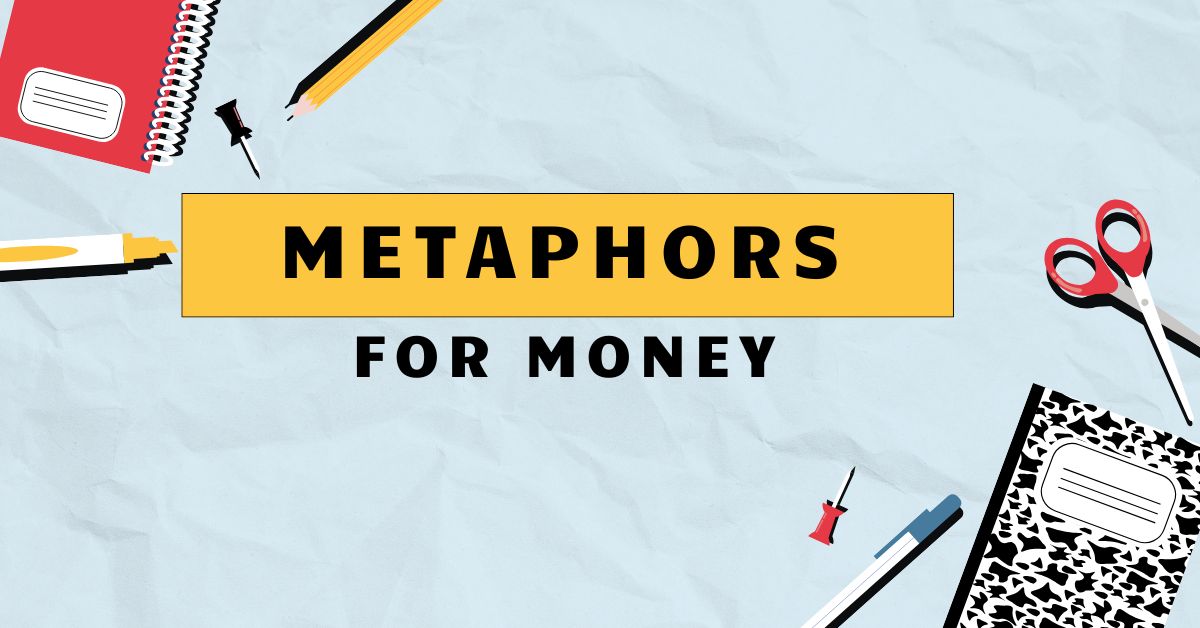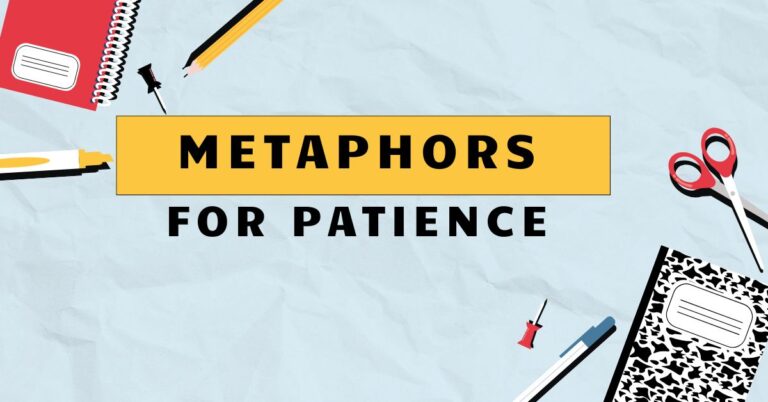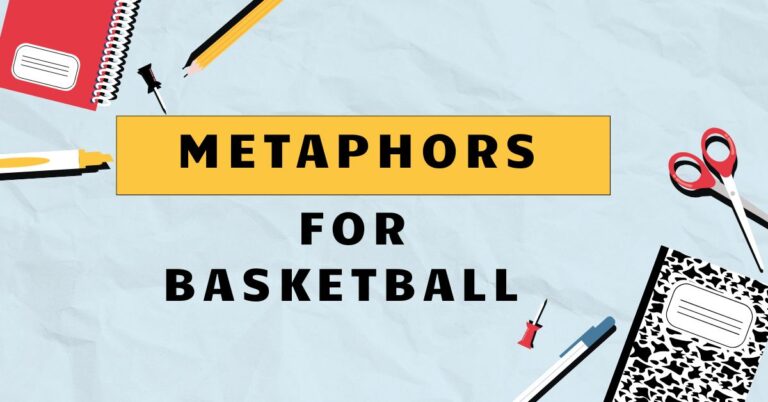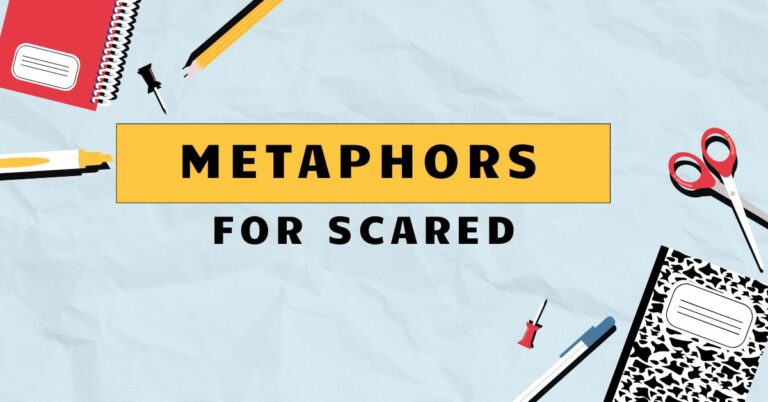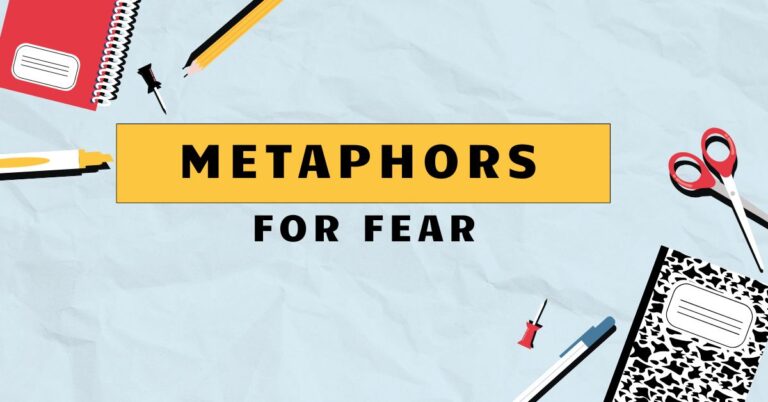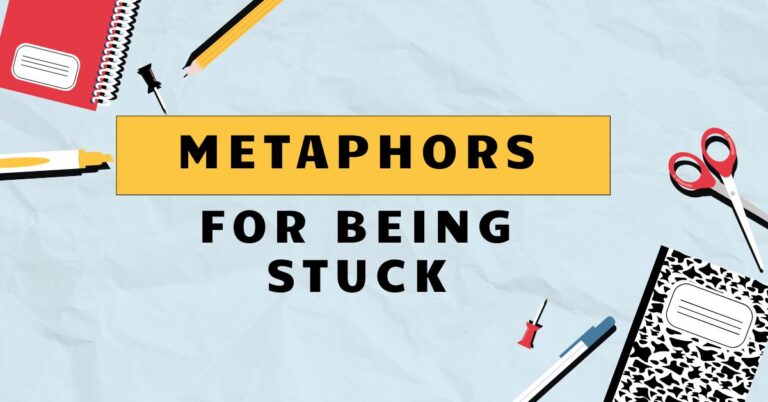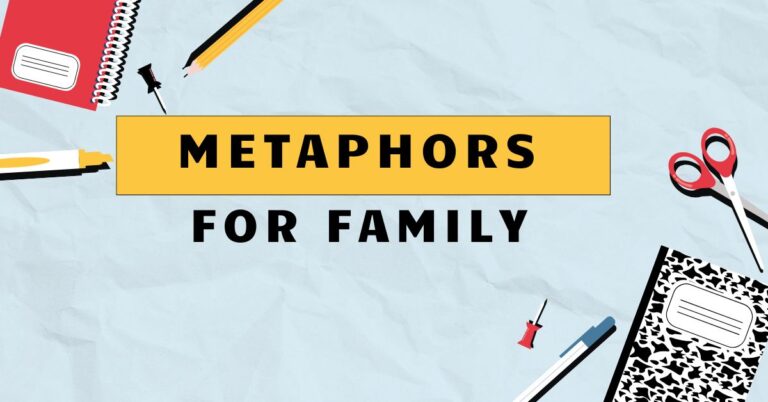43 Metaphors for Money: Understanding Figurative Language
Money, a fundamental aspect of modern life, often transcends its literal value and takes on symbolic meanings. Understanding how we use metaphors to describe money provides insight into our cultural and personal attitudes towards wealth, finance, and economic status.
This article explores the rich landscape of metaphors related to money, offering a comprehensive guide for English language learners and anyone interested in the nuances of financial language. By understanding these metaphors, you can improve your comprehension of financial discussions, literature, and everyday conversations.
Table of Contents
- Introduction
- Definition of Metaphors for Money
- Structural Breakdown
- Types and Categories of Metaphors for Money
- Examples of Metaphors for Money
- Usage Rules for Metaphors for Money
- Common Mistakes When Using Metaphors for Money
- Practice Exercises
- Advanced Topics
- Frequently Asked Questions
- Conclusion
Definition of Metaphors for Money
A metaphor is a figure of speech that directly compares two unrelated things, asserting that one thing *is* another to highlight a shared quality or characteristic. When applied to money, metaphors help us understand and express the abstract value, power, and emotional significance associated with it.
These metaphors often draw on concrete concepts to represent the more intangible aspects of finance.
Metaphors for money are not merely decorative; they actively shape our perception and understanding of economic concepts. They can influence our attitudes towards spending, saving, investing, and even philanthropy.
By framing money in different ways, these metaphors can evoke a range of emotions, from security and comfort to anxiety and greed.
In essence, metaphors for money provide a powerful linguistic tool for conveying complex financial ideas in an accessible and relatable manner. They tap into our shared cultural understanding and personal experiences, enabling us to communicate about money with greater nuance and impact.
Structural Breakdown
The structure of a metaphor typically involves two key elements: thetenorand thevehicle. The tenor is the subject being described (in this case, money), and the vehicle is the object or concept used to represent the subject.
The comparison between the tenor and vehicle is not literal but rather suggestive, highlighting certain attributes that they share.
Consider the metaphor “Money is the root of all evil.” Here, “money” is the tenor, and “root of all evil” is the vehicle. The metaphor doesn’t literally mean that money is a plant root; instead, it suggests that money can be a source of negative consequences and moral corruption.
The effectiveness of the metaphor lies in its ability to evoke a strong emotional response and convey a complex idea in a concise and memorable way.
Another example is “Money talks.” Here, “money” is the tenor, and “talks” is the vehicle. This metaphor implies that money has influence and power, capable of persuading or achieving desired outcomes, similar to how speech can be used to communicate and influence others.
Understanding the tenor and vehicle structure helps in deconstructing and interpreting metaphors for money. By identifying the elements being compared, we can better grasp the underlying meaning and the intended message.
Types and Categories of Metaphors for Money
Metaphors for money can be categorized based on the type of comparison being made. Here are some common categories:
Money as a Source of Nourishment or Sustenance
This category treats money as something essential for survival and well-being, similar to food or water. It emphasizes money’s role in providing for basic needs and maintaining a comfortable lifestyle.
Money as a Liquid
This category focuses on the fluidity and movement of money, highlighting its ability to flow, circulate, and evaporate. It often emphasizes the ease with which money can be acquired or lost.
Money as a Weapon or Tool
This category portrays money as a means of exerting power, influence, or control. It highlights the potential for money to be used for both positive and negative purposes.
Money as a Person or Character
This category personifies money, attributing human characteristics and behaviors to it. It often reflects cultural attitudes and beliefs about wealth and financial responsibility.
Money as a Burden or Weight
This category emphasizes the potential negative consequences of wealth, such as stress, responsibility, and guilt. It highlights the idea that money can be a source of anxiety and hardship.
Money as an Object or Possession
This category treats money primarily as a tangible item, emphasizing its value as something to be accumulated, protected, and displayed. It highlights the material aspects of wealth and the desire for ownership.
Examples of Metaphors for Money
The following tables provide a wide range of examples, categorized for clarity.
Table 1: Money as a Source of Nourishment or Sustenance
This table illustrates how money is often described as something that provides essential needs and supports life, similar to food or water.
| Metaphor | Explanation |
|---|---|
| Money is the lifeblood of the economy. | Money is essential for the economy to function and thrive, just like blood is essential for the body. |
| She’s living off her investments. | Her investments are providing her with the income she needs to survive. |
| He’s starving for cash. | He desperately needs money. |
| This project is fueled by donations. | The project is sustained and powered by financial contributions. |
| They’re feeding their family with that income. | The income is providing sustenance for their family. |
| The company is nourished by strong sales. | Strong sales provide the company with the resources it needs to grow. |
| We need to cultivate our savings. | We need to nurture and grow our savings. |
| His business is blossoming thanks to the loan. | The loan has allowed his business to flourish. |
| Investments are the seeds of future wealth. | Investments can grow into substantial wealth over time. |
| The grant provided much-needed sustenance to the program. | The grant provided essential support to the program. |
| Their financial woes left them parched for resources. | They were desperately lacking in financial resources. |
| The company is being sustained by government subsidies. | Government subsidies are providing the company with the resources it needs to survive. |
| He’s banking on this deal to feed his family. | He’s relying on this deal to provide for his family’s needs. |
| Their savings have withered due to inflation. | Inflation has diminished the value of their savings. |
| The influx of capital revitalized the struggling business. | The new capital gave the business a new lease on life. |
| The company is banking on this deal to nourish its growth. | The company hopes this deal will help it grow. |
| The investment is the bread and butter of their retirement. | The investment is their primary source of income for retirement. |
| The new policy is designed to feed economic growth. | The new policy is designed to promote economic growth. |
| The economy is hungry for investment. | The economy needs investment to grow. |
| Their business is thriving, thanks to a steady stream of customers. | Their business is doing well because they have a lot of customers. |
| The company is being kept alive by government bailouts. | The company is only surviving because the government is giving it money. |
| He’s hoping to harvest a profit from his investments. | He’s hoping to make a profit from his investments. |
| The new tax cuts are designed to feed the economy. | The new tax cuts are designed to stimulate the economy. |
| They’re relying on their savings to get them through hard times. | They’re using their savings to support themselves during difficult periods. |
| The company is hoping to cultivate new markets. | The company is hoping to develop new markets. |
Table 2: Money as a Liquid
This table illustrates how money is often described as a fluid substance that can flow, circulate, and sometimes disappear quickly.
| Metaphor | Explanation |
|---|---|
| Money flows freely in the stock market. | Money is easily transferred and exchanged in the stock market. |
| He’s swimming in cash. | He has a large amount of money. |
| The money is drying up. | The supply of money is decreasing. |
| The company is hemorrhaging money. | The company is losing money very quickly. |
| They’re drowning in debt. | They have a large amount of debt. |
| The funds were channeled into the project. | The money was directed towards the project. |
| The economy is awash with liquidity. | There is a large amount of money available in the economy. |
| The money trickled down to the lower classes. | The benefits of economic growth gradually reached the lower classes. |
| The river of money flowed into their coffers. | A large amount of money was deposited into their accounts. |
| The company is flush with cash. | The company has a lot of money available. |
| His wealth evaporated overnight. | He lost his wealth very quickly. |
| The investment is a cash cow. | The investment generates a lot of money. |
| The funds are being siphoned off illegally. | The money is being stolen. |
| The company is trying to stem the flow of losses. | The company is trying to stop losing money. |
| The market is flooded with cheap imports. | There are a lot of cheap imports available in the market. |
| The money is circulating through the economy. | Money is being exchanged and used throughout the economy. |
| The funds were diverted to other projects. | The money was redirected to different projects. |
| The economy is in a liquidity trap. | Interest rates are low, but people are not investing. |
| The cash is flowing out of the country. | Money is leaving the country. |
| The company is trying to dam the flow of red ink. | The company is trying to stop the losses. |
| He poured money into the project. | He invested a lot of money in the project. |
| The investment has dried up. | The investment is no longer generating income. |
| The company is bleeding cash. | The company is losing money quickly. |
| The bailout stemmed the tide of bankruptcies. | The bailout stopped the bankruptcies. |
| The market is saturated with similar products. | There are too many similar products on the market. |
Table 3: Money as a Weapon or Tool
This table illustrates how money can be used to exert power, influence, or control, similar to a weapon or tool.
| Metaphor | Explanation |
|---|---|
| Money talks. | Money has influence and power. |
| He used his wealth to bulldoze the competition. | He used his wealth to overcome his competitors. |
| She leveraged her assets to secure the loan. | She used her assets as collateral to get the loan. |
| They wielded their financial power to influence the election. | They used their money to affect the outcome of the election. |
| Money is a tool to achieve your goals. | Money can be used to reach your objectives. |
| He has a golden touch. | He is very successful at making money. |
| They’re using money as a bargaining chip. | They’re using money as a negotiating tactic. |
| His wealth opened doors for him. | His wealth created opportunities for him. |
| Money is a double-edged sword. | Money can have both positive and negative effects. |
| He bought his way into the company. | He used his money to acquire a position in the company. |
| They’re using money to grease the wheels. | They’re using money to facilitate a process. |
| She’s armed with a substantial inheritance. | She has a significant financial advantage. |
| They’re using their wealth to build an empire. | They’re using their money to create a powerful and influential organization. |
| He’s trying to buy influence with his donations. | He’s trying to use his donations to gain influence. |
| The company is using its financial muscle to dominate the market. | The company is using its financial strength to control the market. |
| Money is the key to success. | Money is essential for achieving success. |
| He used his wealth to pave the way for his children. | He used his wealth to create opportunities for his children. |
| They’re using their financial resources to wage a legal battle. | They’re using their money to fight a legal case. |
| Money is a lever to move the world. | Money can be used to effect change in the world. |
| He used his wealth to break down barriers. | He used his wealth to overcome obstacles. |
| They are using their wealth as a shield against criticism. | They are using their money to protect themselves from criticism. |
| He used his money to silence his critics. | He used his money to stop people from criticizing him. |
| They are using their wealth to build bridges. | They are using their money to create connections and relationships. |
Table 4: Money as a burden or weight
This table illustrates how money can be perceived as a source of stress or responsibility.
| Metaphor | Explanation |
|---|---|
| Money is a heavy burden. | Having a lot of money can be stressful and difficult to manage. |
| The weight of wealth was crushing him. | The responsibilities and pressures that came with wealth were overwhelming him. |
| The inheritance felt like a millstone around her neck. | The inheritance was a constant source of worry and anxiety. |
| He was weighed down by his financial obligations. | He felt burdened by the amount of money he owed. |
| The responsibility of managing the company’s finances was a heavy load to bear. | The task of overseeing the company’s money was very difficult and stressful. |
| He felt trapped by his wealth. | He felt like his money was controlling his life and limiting his freedom. |
| The debt was a constant drag on their resources. | The debt was constantly draining their money and making it difficult to achieve their goals. |
| His fortune became a source of endless worry. | His wealth caused him a lot of stress and anxiety. |
| The burden of managing the foundation’s assets was immense. | The task of overseeing the foundation’s money was very difficult and time-consuming. |
| She felt suffocated by her family’s wealth. | She felt like her family’s money was controlling her life and preventing her from living the way she wanted to. |
Table 5: Money as a person or character
This table illustrates how money can be personified, taking on human-like qualities.
| Metaphor | Explanation |
|---|---|
| Money makes the world go round. | Money is the driving force behind many activities and decisions. |
| Money is no object. | Cost is not a concern; one is willing to spend whatever it takes. |
| Money can’t buy happiness. | Having money does not guarantee contentment or fulfillment. |
| Money is the best medicine. | Money can solve many problems and improve one’s quality of life. |
| Money is a good servant but a bad master. | Money can be useful, but it should not control one’s life. |
| Money doesn’t grow on trees. | Money is not easily obtained; it requires hard work and effort. |
| Money is a silent partner. | Money is an important factor that contributes to success, even if it’s not always visible. |
| Money is the mother’s milk of politics. | Money is essential for political campaigns and activities. |
| Money is a jealous mistress. | Money requires constant attention and can be demanding. |
| Money is a universal language. | Money can facilitate communication and transactions between people from different cultures and backgrounds. |
Usage Rules for Metaphors for Money
When using metaphors for money, consider the following guidelines:
- Context is crucial: The appropriateness of a metaphor depends on the context. Formal financial reports may require more precise language, while informal conversations can accommodate more creative metaphors.
- Audience awareness: Tailor your metaphors to your audience. A metaphor that resonates with one group may be confusing or offensive to another.
- Clarity is key: Ensure that your metaphors are easily understood. Overly complex or obscure metaphors can hinder communication rather than enhance it.
- Avoid clichés: While some common metaphors are effective, overuse can make your language sound unoriginal. Strive for fresh and imaginative comparisons.
- Consistency matters: Maintain consistency in your metaphorical language. Mixing metaphors can create confusion and weaken your message.
Common Mistakes When Using Metaphors for Money
Here are some common errors to avoid:
- Mixing metaphors: Combining unrelated metaphors can create nonsensical or contradictory images.
- Using clichés excessively: Overreliance on tired metaphors can make your writing or speech sound uninspired.
- Misunderstanding the metaphor’s meaning: Using a metaphor incorrectly can convey the wrong message or confuse your audience.
- Ignoring the context: Employing a metaphor that is inappropriate for the situation can undermine your credibility.
Table 6: Correct vs. Incorrect Examples
This table highlights common mistakes in using metaphors for money and provides the correct usage.
| Incorrect | Correct | Explanation |
|---|---|---|
| “The company is swimming in debt and also fueled by donations.” | “The company is swimming in debt.” OR “The company is fueled by donations.” | Mixing metaphors of drowning in debt and being fueled is confusing. |
| “Money doesn’t grow on trees, but it’s a cash cow.” | “Money doesn’t grow on trees; you have to work hard for it.” OR “That investment is a cash cow.” | Contradictory metaphors; “doesn’t grow on trees” implies scarcity, while “cash cow” implies abundance. |
| “He used his wealth to bulldoze the competition, but it was also a heavy burden.” | “He used his wealth to bulldoze the competition.” OR “His wealth became a heavy burden.” | Mixing the tool/weapon metaphor with the burden metaphor creates confusion. |
Practice Exercises
Test your understanding with these exercises.
Exercise 1: Identifying Metaphors
Identify the metaphor in each sentence and explain its meaning.
Table 7: Exercise 1 – Identifying Metaphors
| Question | Answer |
|---|---|
| 1. The stock market is a roller coaster. | The metaphor is “roller coaster.” It means the stock market experiences unpredictable and dramatic ups and downs. |
| 2. Debt is a bottomless pit. | The metaphor is “bottomless pit.” It means debt is a situation that seems impossible to escape from, as there is no end in sight. |
| 3. Her business is a money tree. | The metaphor is “money tree.” It means her business is a source of constant profit. |
| 4. Money is the oxygen of a startup. | The metaphor is “oxygen.” It means money is essential for a startup to survive. |
| 5. He’s buried under a mountain of bills. | The metaphor is “mountain of bills.” It means he has a large amount of bills to pay. |
| 6. The grant was a lifeline for the struggling artist. | The metaphor is “lifeline.” It means the grant provided essential support for the artist to survive. |
| 7. The new policy is designed to jumpstart the economy. | The metaphor is “jumpstart.” It means the new policy is designed to stimulate the economy and get it moving again. |
| 8. The company is navigating rough financial waters. | The metaphor is “rough financial waters.” It means the company is facing difficult financial challenges. |
| 9. Their savings were a safety net in times of crisis. | The metaphor is “safety net.” It means their savings provided them with financial security in times of difficulty. |
| 10. The investment proved to be a gold mine. | The metaphor is “gold mine.” It means the investment generated a lot of profit. |
Exercise 2: Fill in the Blanks
Complete the sentences with appropriate metaphors for money.
Table 8: Exercise 2 – Fill in the Blanks
| Question | Answer |
|---|---|
| 1. The company is _________ money due to poor management. | hemorrhaging |
| 2. He hopes his investment will _________ a profit in the long run. | yield |
| 3. The donation was a _________ for the charity. | lifeline |
| 4. Their wealth _________ doors that were previously closed to them. | opened |
| 5. The new tax policy is expected to _________ economic growth. | fuel |
| 6. She _________ her assets to secure a better interest rate. | leveraged |
| 7. The company is _________ in debt after the failed project. | drowning |
| 8. Money is often described as the _________ of all evil. | root |
| 9. The market is _________ with cheap imports, making it difficult for local businesses to compete. | flooded |
| 10. He used his money to _________ his way into a prestigious position. | buy |
Exercise 3: Rewriting Literal Statements with Metaphors
Rewrite the following literal statements using metaphors for money.
Table 9: Exercise 3 – Rewriting with Metaphors
| Question | Answer |
|---|---|
| 1. The company is losing a lot of money quickly. | The company is bleeding cash. |
| 2. He invested a large amount of money in the project. | He poured money into the project. |
| 3. The economy needs more investment to grow. | The economy is hungry for investment. |
| 4. Her business is a source of constant profit. | Her business is a money tree. |
| 5. He has a lot of money. | He is swimming in cash. |
| 6. The project is sustained by financial contributions. | The project is fueled by donations. |
| 7. He is using his money to try to gain influence. | He is trying to buy influence with his donations. |
| 8. The new policy is designed to stimulate the economy. | The new policy is designed to jumpstart the economy. |
| 9. The money was directed toward the project. | The funds were channeled into the project. |
| 10. Money is essential for the economy to function. | Money is the lifeblood of the economy. |
Advanced Topics
For advanced learners, consider exploring the cultural variations in metaphors for money. Different cultures may have unique ways of conceptualizing money, reflecting their specific values and beliefs.
Additionally, research the use of metaphors in financial journalism and literature to analyze how these figures of speech shape public perception of economic issues.
Delve into the study of cognitive linguistics to understand how metaphors influence our thought processes and decision-making related to money. Explore the ethical implications of using metaphors in financial advertising and marketing, considering how these figures of speech can be used to persuade or manipulate consumers.
Frequently Asked Questions
Q1: Why are metaphors used to describe money?
Metaphors are used to describe money because money is often an abstract concept. By comparing money to something more concrete and relatable, such as a liquid or a source of nourishment, we can better understand its value, function, and impact.
Q2: Can metaphors for money influence our financial decisions?
Yes, metaphors can influence our financial decisions by shaping our perceptions and emotions related to money. For example, if we view money as a weapon, we may be more inclined to use it aggressively to achieve our goals.
Conversely, if we view money as a burden, we may be more cautious and risk-averse.
Q3: Are some metaphors for money more common than others?
Yes, some metaphors for money are more common due to their cultural relevance and ease of understanding. For example, the metaphor “money talks” is widely recognized and used to convey the idea that money has influence and power.
Q4: How can I improve my understanding of metaphors for money?
To improve your understanding of metaphors for money, pay attention to how money is described in various contexts, such as news articles, financial reports, and everyday conversations. Analyze the underlying meaning of the metaphors and consider their potential impact on your perceptions and attitudes.
Q5: Is it okay to mix metaphors when talking about money?
It’s generally best to avoid mixing metaphors, as it can create confusion and weaken your message. However, in informal contexts, a mixed metaphor may be acceptable if it is clear and effective.
Q6: Can metaphors for money be used in a negative way?
Yes, metaphors for money can be used in a negative way to criticize or condemn certain financial practices or attitudes. For example, the metaphor “money is the root of all evil” is often used to express disapproval of greed and materialism.
Q7: How do different cultures perceive money, and how does it affect the metaphors they use?
Different cultures have different values and attitudes towards money, which can influence the metaphors they use to describe it. For example, cultures that emphasize community and sharing may use metaphors that portray money as a resource to be distributed, while cultures that value individual achievement may use metaphors that emphasize money as a measure of success.
Q8: How can metaphors be used to make complex financial concepts more accessible?
Metaphors can simplify complex financial concepts by relating them to familiar and understandable ideas. For instance, describing inflation as “eroding” the value of money makes the concept more intuitive than using technical jargon.
Q9: What are some examples of metaphors used in personal finance advice?
Personal finance advice often uses metaphors like “building a nest egg” (saving for retirement), “diversifying your portfolio” (spreading investments to reduce risk), and “staying afloat” (managing debt). These metaphors provide relatable images that simplify financial planning.
Q10: How do metaphors for money reflect societal values?
Metaphors for money often reflect a society’s values, such as its emphasis on wealth, security, or ethical behavior. A society that values wealth accumulation might use metaphors that glorify riches, while a society that prioritizes ethical behavior might use metaphors that warn against the dangers of greed.
Conclusion
Metaphors for money are a powerful and pervasive aspect of our language, shaping our understanding and perception of wealth, finance, and economic concepts. By recognizing and analyzing these metaphors, we can gain valuable insights into our own attitudes towards money and the cultural values that influence our financial decisions.
Understanding these metaphors not only enhances our linguistic skills but also provides a deeper understanding of the complex relationship between language, money, and society.
As you continue to learn English, pay close attention to the metaphors used in financial discussions and literature. By expanding your vocabulary and analytical skills, you will become a more effective communicator and a more informed participant in the global economy.
Remember that metaphors are not just decorative flourishes; they are powerful tools that can shape our thoughts and actions.

